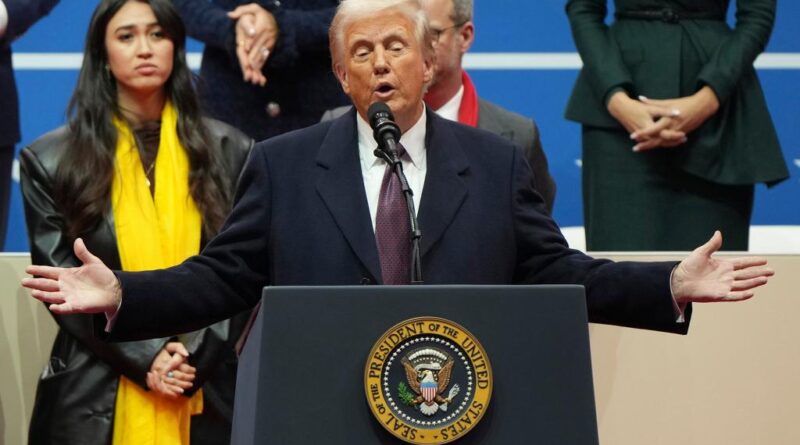Trump’s Wave of Executive Orders Demonstrates His Ability to Hit the Ground Running

Donald Trump is taking a different approach this time around.
In 2017, Trump arrived in Washington with great force, disrupting and scattering the political landscape — yet many of his initiatives failed to materialize.
Quickly launched proposals often fell apart, unable to pass through Congress or withstand negative media coverage and court challenges.
His presidency was hampered by numerous investigations.
The border wall remained unbuilt.
Trump handed Paul Ryan a tax bill and Mitch McConnell judicial appointments, but he was ill-prepared to fully implement his own proposals.
This Monday, Trump began his new term with momentum.
He introduced a slew of executive orders that his team had meticulously prepared, with plans to sign 100 or more on his first day.
He even set up a desk at the Capital One arena for ceremonial signings in front of the audience.
Most of the orders were not confidential, despite Democrats being preoccupied with the Heritage Foundation’s Project 2025 and neglecting Trump’s own “Agenda 47″ promises.
Some of the initiatives Trump mentioned in his inaugural speech will require congressional backing, but the executive orders primarily focus on actions the president can undertake independently.
This marks a stark contrast to Joe Biden, who frequently bypassed traditional presidential roles and instead utilized executive orders for issues typically within Congress’s or states’ jurisdiction, such as student-loan forgiveness, eviction moratoriums, and workplace vaccine mandates.
The emphasis is on immigration.
Trump has a distinct mandate to diverge from previous administrations on this issue.
By declaring a national emergency at the border, he plans not only to restore his successful policies like “Remain in Mexico” (requiring asylum-seekers to wait outside the U.S.) but also to deploy military forces to the southern border and halt the catch-and-release system as well as refugee resettlement.
He aims to confront Mexican cartels by designating them as foreign terrorist organizations and employing a law enacted by John Adams to target criminal gangs as alien enemies.
The cartels, which dominate a third of Mexico’s territory and manipulate its government, have never encountered anything like this before.
In a more contentious approach, he’s challenging Supreme Court rulings and constitutional language by attempting to abolish birthright citizenship for the offspring of undocumented immigrants.
This move is less likely to succeed.
Anticipate legal battles ahead, but much of this aligns with the president’s military and law enforcement authority.
Trump’s message will rapidly resonate globally: a new sheriff is enforcing the law at the border.
Additionally, he plans to declare a national energy emergency and tackle inflation and energy shortages.
Details on how much of Biden’s “green energy” initiatives will be rolled back or what the new Department of Government Efficiency will eliminate are still unclear, requiring congressional collaboration.
However, he plans to revoke the electric vehicle mandate and promote increased drilling and mining: Drill, baby, drill!
On trade, Trump is not rolling out new tariffs on Day One, but he’s enhancing the government’s tariff-collecting capabilities to leverage potential tariffs in negotiations with foreign leaders.
If he’s savvy, he’ll use this leverage to secure better trade agreements instead of imposing tariffs that merely raise prices for consumers.
Trump vows to end the era of wokeness and the chaos of COVID-19 with executive orders that cease government pressure for social media censorship, eliminate racial preferences and DEI, affirm that there are only two genders, and reinstate service members discharged for refusing the COVID vaccine with back pay.
However, his intention to issue an executive order to allow TikTok to operate for another 90 days risks perpetuating Chinese government influence on American devices.
Additionally, he’s engaging in symbolic gestures, promising to officially rename the Gulf of Mexico to “the Gulf of America” and restoring the name of Mount McKinley to its Alaskan name, Denali, for a few years.
Congress will become a crucial battleground when Trump seeks additional funding for border security and when his 2017 tax cuts near expiration.
Previously, Trump often appeared unaware of his executive abilities: governing is more complicated than it appears.
Yet he seems better prepared this time, and at 78, the man who proclaims, “I was saved by God to make America great again,” is approaching his new term with a renewed sense of urgency.
Dan McLaughlin is a senior writer at National Review Online.



